武汉大学研究生英语课文原文 Stumbling Blocks in Intercultural
研究生学位英语课文全文翻译-unit3

Unit3 美国人的酷爱1 我父亲是别克人。
在经济大萧条以前,他本是史达兹人。
然而,就像成千上万经济状况处于上升阶段的有车族一样,那场可悲的经济逆转使他们非得调整对汽车的胃口不可。
到他死的时候,他开过的那些别克轿车就不只是普通意义上的交通工具了,而且将父亲定位于这样的社会阶层——比庞蒂亚克人富有,但比不上克迪拉克人。
拥有别克轿车让人一看便知父亲的社会地位。
与别克人相当的还有福特人和克莱斯勒人。
2 我们美国人与汽车的特殊缘分,其坚实的基础就在于对一种轿车品牌的忠诚,这种忠诚因其来之不易而倍受珍惜。
·这就是爱吗?也许用词过分,可美国人对这些机器的尊重甚过所有其他机器——不仅将它们视为20世纪雕塑大观中的标志,而且还将它们视为社会的护身符。
我记忆中的第一辆别克车是一辆闪闪发亮的黑色轿车,椅子的衬垫是厚厚的马海毛,离合器拉杆是新式的。
我父亲爱吹嘘说这辆车一小时能跑120英里。
一想到这样的速度就会令男人们兴奋不已。
我照着家里的菲尔可牌收音机盒里播出的格林,霍利特驾驶的那个神秘机器的名字,给这头漂亮的牲口取了个名副其实的绰号——黑美驹。
3 20世纪中,电话、电视或者个人电脑,这一切都使人类环境发生了巨大变化。
然而,与电话、电视、电脑不同的是,汽车却享有人格化的地位。
有些汽车可以成为家庭成员,机械宠物。
我们给汽车起名字,在自己家的车道上精心打扮汽车,在汽车不能满足我们的需要时诅咒它们。
在折旧换新之时为旧车的离去而悲哀。
4 人们对汽车的热爱让环境保护者、安全为重的倡导者以及社会工程师们感到不安。
他们认为通往人间天堂的道路应该到处都铺设公交运输所必备的发亮轨道。
他们想象着我们加入未来拥挤不堪的自行车行列,而不是像一位激动不已的评论家所预见的那样,坐在“傲慢的双轮马车”方向盘后。
这种态度不是现在才有的。
首先是铁路,接着是汽车造成的人口流动早已使得守旧的特权阶层感到不安。
在战场上有过辉煌,但却以鄙视下层民众而出名的威林顿公爵在150年前就曾反对英国发展铁路,这是因为火车只会怂恿普通人毫无意义地到处走动。
武汉大学研究生英语课文原文 Stumbling Blocks in Intercultural
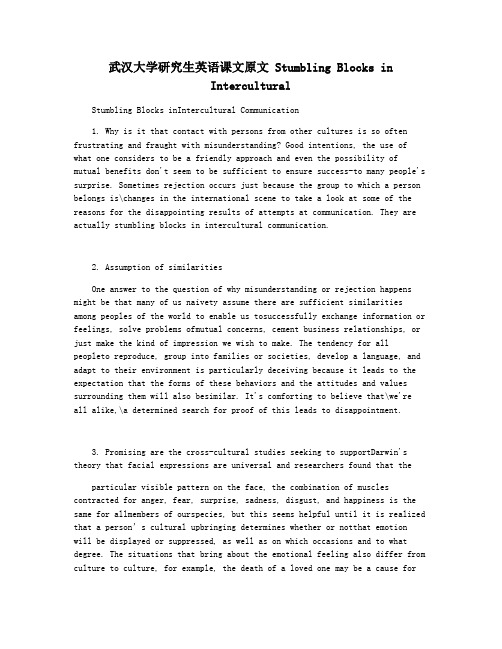
武汉大学研究生英语课文原文 Stumbling Blocks inInterculturalStumbling Blocks inIntercultural Communication1. Why is it that contact with persons from other cultures is so often frustrating and fraught with misunderstanding? Good intentions, the use of what one considers to be a friendly approach and even the possibility of mutual benefits don't seem to be sufficient to ensure success-to many people's surprise. Sometimes rejection occurs just because the group to which a person belongs is\changes in the international scene to take a look at some of the reasons for the disappointing results of attempts at communication. They are actually stumbling blocks in intercultural communication.2. Assumption of similaritiesOne answer to the question of why misunderstanding or rejection happens might be that many of us naivety assume there are sufficient similarities among peoples of the world to enable us tosuccessfully exchange information or feelings, solve problems ofmutual concerns, cement business relationships, or just make the kind of impression we wish to make. The tendency for all peopleto reproduce, group into families or societies, develop a language, and adapt to their environment is particularly deceiving because it leads to the expectation that the forms of these behaviors and the attitudes and values surrounding them will also besimilar. It's comforting to believe that\we'reall alike,\a determined search for proof of this leads to disappointment.3. Promising are the cross-cultural studies seeking to supportDarwin's theory that facial expressions are universal and researchers found that theparticular visible pattern on the face, the combination of muscles contracted for anger, fear, surprise, sadness, disgust, and happiness is the same for allmembers of ourspecies, but this seems helpful until it is realized that a person’s cultu ral upbringing determines whether or notthat emotionwill be displayed or suppressed, as well as on which occasions and to what degree. The situations that bring about the emotional feeling also differ from culture to culture, for example, the death of a loved one may be a cause forjoy, sorrow, or some other emotion, depending upon the accepted cultural belief.4. Since there seems to be no universals of “human nature” that can be used as a basis for automatic understanding, we must treat each encounter as an individual case, searching for whatever perceptions and communication means are held in common and proceed from there. If we realize that we are all culture bound andculturally modified, we will accept the fact that, being unlike, wedo not reallyknow what someone else\5. The aura of similarity is a serious stumbling block to successful intercultural communication. A look-alike facade is deceiving when representatives from contrasting cultures meet, eachwearing Western dress, speaking English, and using similar greeting rituals. It is like assuming that New York, Tokyo, and Tehran are all alike because each has the appearance of a moderncity. Without being alert to possible differences and the needto learn new rules for functioning, persons going from one city tothe other will be in immediatetrouble, even when acting simple roles such as pedestrian and driver.6. Theconfidence that goes with the myth of similarity is much more comfortable than the assumption of differences, the latter requiring tentative assumptions and behaviors and a willingness toaccept the anxietyof\knowing.\with the assumptionof differences, however, can reactionsandinterpretationsbeadjustedtofit\happening.\someone is likely tomisread signs and judge the sceneethnocentrically.7. The stumbling block of assumedsimilarity is a “troublem,”as one English learner expressed it, not only for the foreigner but for the people in the host country with whom the internationalvisitor comes into contact. The native inhabitants are likely to be lulled into the expectation that, since the foreign person isdressed appropriately and speak some of the language, heor she will also have similar nonverbal codes, thoughts and feelings. Thus, nodding, smiling, and affirmative comment will probably be confidentlyinterpreted as meaning that they have informed,helped, and pleased the newcomer. It is likely, however, that theforeigner actually understood very little of the verbal and nonverbal content and was merely indicating polite interest or trying not to embarrass himself or herself of the host with verbalized questions. 8. Language DifferenceThe second stumbling block is so obvious that it hardly needs mentioning--language. Vocabulary, syntax, idioms, slang, dialects, and so on all cause difficulty, but the person strugglingwith a different language is at least aware of being in this kind oftrouble. A worse language problem is thetenacity with whichsomeone will cling to just one meaning of a word or phrase in thenew language, regardless of connotation or context. The variations in possible meaning, especially if inflection and tonal qualities are added, are so difficult to cope with that they are oftenwaved aside. The reason this problem is worse than simple struggling to translate foreign words is because each person thinks heor she understands. The nationwide misinterpretation of Khrushchev's sentence \example.Even\causetrouble.WhenaJapanesehears,\you have some tea?\or she listens to the literalmeaning of the sentence and answers,\that he orshe wants some.\host or hostess that there may be a misunderstanding. Also, in some culture, it is polite to refuse the first or second offer of refreshment. Many foreign guests have gone hungrybec ause their US host or hostess never presented the thirdoffer―another case of “no\9. Nonverbal misinterpretationsLearning the language, which most visitors to foreign countries consider their only barrier to understanding, is actually onlythe beginning. The third stumbling block is nonverbal misinterpretations. People from differentcultures inhabit different sensory realities. They see, hear, feel, and smell only that which has some meaning or importance for them. They abstractwhatever fits into their personal world of recognition and then interpret itthrough the frame of reference of their own culture. For example, a Saudi Arab would nonverbally signal that he liked a girl by smoothing back his hair, which to an American girl would be justa common nervous gesture signifying noting.10. The lack of comprehension ofnonverbal signs and symbols that are easyto observe--such as gestures, postures, and otherbody movements--is a definite communication barrier. But it is possible to learn the meanings of these observable messages, usually in informal rather than formal ways. It is more difficult tonote correctly the unspoken codes of the other culture that are further from awareness, such as the handling of time and spatialrelationships and subtle signs of respect of formality. 11. The Presence of Preconceptions and StereotypesThe fourth stumbling block is the presence of preconceptions and stereotypes. If the label\inscrutable\thus we explain the Japanese constantand inappropriate smile. The stereotype that Arabs are\”may cause the US students to keep their distance or even alert authorities when an animated and noisy group from the Middle Eastgathers. A professor who expects everyone from Indonesia,Mexico, and many other countries to%unfairly interpret a hesitationor request from an international student as amove to manipulate preferential treatment.12. Stereotypes help do what Ernest Becker says the anxiety--prone human race must do--reduce the threat of the unknownby making theworld predictable. Indeed, this is one of the basicfunctions of culture:to lay out a predictable world in which the individual is firmly oriented. Stereotypes are overgeneralized, secondhand beliefs that provide conceptual bases from which to\whether or not they are accurate or fit the circumstances. In a foreign land theiruse increases our feeling of security and is psychologically necessary to the degree that we cannot tolerate ambiguity orthe senseof helplessness resulting from inability to understand and dealwith people and situations beyond our comprehension.13. Stereotypes are stumbling blocks for communicators becausetheyinterfere with objective viewing of stimuli--the sensitivesearch for cues to guide the imagination toward the other persons' reality. Stereotypes are not easy to overcome in ourselves or tocorrect in others, even with thepresentation of evidence. Theypersist because they are firmly established as myths or truisms byone's own national culture and because they sometimesrationalize prejudices. They are also sustained and fed by the tendency toperceive selectively only those pieces of new information that correspond to the image held.14. ThePractice ofImmediate EvaluationThe fifth stumbling block and another deterrent to understanding between persons of differing cultures or ethnic groups isthe tendency to evaluate, to approve or disapprove, the statements and actions of the other person or group. Rather than to try to comprehend completely the thoughts and feelings expressedfrom the world view of the other, we assume our own culture or way of life always seems right, proper, and natural. This biasprevents the open-minded attention needed to look at the attitudes and behavior patterns fromthe other’s point of view.15. Fresh from a conference in Tokyo where Japanese professorshad emphasized the preference the people of Japan for simple natural settings感谢您的阅读,祝您生活愉快。
研究生英语精读教程课文原文+翻译+短文unit3

Rats and Men"Insoluble" ProblemsProfessor N. R. F. Maier of the University of Michigan performed a series of experiments several years ago in which "neurosis" is induced in rats. The rats are first trained to jump off the edge of a platform at one of two doors.If the rat jumps to the right, the door holds fast, and it bumps its nose and falls into a net; if it jumps to the left, the door opens, and the rat finds a dish of food. When the rats are well trained to this reaction, the situation is changed. The food is put behind the other door, so that in order to get their reward they now have to jump to the right instead of to the left. (Other changes, such as marking the two doors in different ways, may also be introduced by the experimenter.)If the rat fails to figure out the new system, so that each time it jumps it never knows whether it is going to get food or bump its nose, it finally gives up and refuses to jump at all. At this stage, Dr. Maier says, "Many rats prefer to starve rather than make a choice."密执安大学的N.R.F. 麦耶教授几年前做过一系列可以诱导鼠产生“神经官能症”的实验。
武汉大学研究生英语英汉互译全部内容
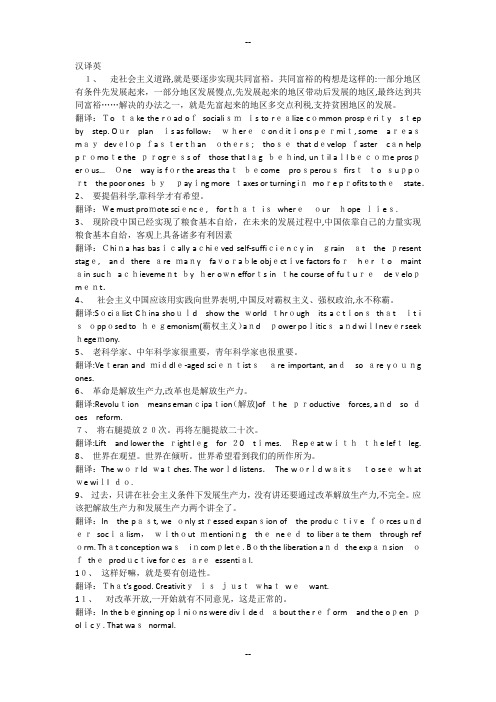
汉译英1、走社会主义道路,就是要逐步实现共同富裕。
共同富裕的构想是这样的:一部分地区有条件先发展起来,一部分地区发展慢点,先发展起来的地区带动后发展的地区,最终达到共同富裕……解决的办法之一,就是先富起来的地区多交点利税,支持贫困地区的发展。
翻译:To take the road ofsocialismis to realize common prosperity step by step. Our planis as follow:whereconditions permit, some areasmaydevelop faster thanothers;thosethat develop faster can help promote the progress of those that lag behind, until all become prosperous…One way is for the areas thatbecome prosperousfirstto support the poor ones bypaying more taxes or turning inmore profits to thestate.2、要提倡科学,靠科学才有希望。
翻译:We must promote science,for thatiswhereourhope lies.3、现阶段中国已经实现了粮食基本自给,在未来的发展过程中,中国依靠自己的力量实现粮食基本自给,客观上具备诸多有利因素翻译:China has basically achieved self-sufficiency ingrainat the present stage,andthere are many favorable objective factors forher to maint ain suchachievement by her own efforts in the course of futuredevelopment.4、社会主义中国应该用实践向世界表明,中国反对霸权主义、强权政治,永不称霸。
武汉大学研究生英语课文原文 Gender,poverty and environment

Gender, Poverty and EnvironmentGender is rarely considered as a mainstream issue in environmental policies and programmers. However, a better understanding of the different priorities and perceptions of men and women can be used to maximize policy effectiveness.1.In many parts of the world, women tend to be the poorest of the poor in avery literal sense. In addition to being the majority among the poor, they are often denied the most basic rights and access to critical resources such as land, inheritance or credit. Their labour and knowledge are undervalued.Their needs are often overlooked. They are more vulnerable to disease and disasters and the situation is made worse by their poverty. Cultural and social norms sometimes complicate matters further by placing additional expectations, restrictions and limitations on women. Gender gaps are widespread, and in no region of the world are women equal to men in legal, social and economic rights.2.The synergies between the goals of gender equity, poverty alleviation andenvironmental sustainability are explored below in terms of addressing poverty among women--including energy and water poverty, health, climate change, natural disasters and creating sustainable livelihoods by empowering women in the realms of agriculture, forest and biodiversity management.3.Energy, environment and genderThe synergies between gender, environment and the energy sector were first recognized in relation to biomass energy. Women were recognized as users and collectors of fuel wood, and as victims of environmental deterioration that caused energy scarcity.4.The surveys have shown that women spend long hours in fuel collection.The burden increases as deforestation worsens, and this affects the timeavailable to women for other activities including income-generating activities, education and participation in decision making. In Sudan, for instance, deforestation in the last decade led to a quadrupling of the time women spent gathering fuel wood. This stimulated efforts to promote afforestation and design more fuel-efficient stoves. Funding petered out, however, when the improved stoves and forestry projects were not as successful as anticipated.5.Attention to biomass energy and its impact on women's lives has recentlyrevived. Indoor air pollution, mainly from wood fuel smoke, ranked as the fourth largest health problem in developing countries. It is estimated to kill2 million women and children in developing countries every year and alsocauses respiratory and eye diseases. There are differences in exposure according to age and economic status, and in some cultures women tend to undervalue their own health, leading to under-reporting of problems.6.In many developing countries, communal lands remain a crucial source ofbiomass energy, yet privatization of these lands continues apace--reducing free access to fuel wood, and removing yet another where cooperative decisions could be made on sustainable management of fuel wood sources.7.In developed countries, the links between gender, environment and energyhave been explored mainly in the areas of equal opportunity in the energy professions, decision making in energy policy, pollution and health, preferences for energy production systems, access to scientific and technological education and the division of labour in the home.8.Climate change and genderClimate change is predicted to cause displacement of populations due to sea level rise. In many parts of the developing world it is expected to increase water scarcity, to increase the disease burden, to negatively impact agriculture, and to cause more frequent extreme weather events. The effects of climate change and adaptive capacity are very likely to differ by gender, because of the strong relationship between poverty and vulnerability, andthe fact that women as a group are poorer and less powerful than men.9.The potential value of gender as a factor in deciding on policies andprogrammes to reduce greenhouse gas emissions has received even less attention. For example, as users of household energy, women can play a key role in energy conservation, as well as in promoting renewable energy technologies.10.Both sexes make decisions about the forms of transport they use and howfrequently they travel, and there are gender differences in the choices they make. In developed countries, for example, women tend to use public transport more than men.nd tenure and agricultureDespite women's key role in agriculture, most of the world’s women do not equally own, inherit or control land and other property.Discriminatory inheritance and property ownership laws restrict women's ability to ensure long-term food security for the family, and to get loans using land as collateral. They also have important consequences for soil and land management --it is widely acknowledged that owners of land take more care to ensure soil conservation. Improved access to agricultural support systems, including credit, technology, education, transport, extension and marketing services, is essential to improving agricultural productivity and promoting environmentally sustainable practices--yet often women have no access to these services.12.The division of labour between men and women in agricultural productionvaries considerably between cultures. However, as a broad generalization, It is usually men who are responsible for large-scale cash cropping, especially when it is highly mechanized, while women take care of household food production and some small-scale, low technology cultivation of cash crops. This has important implications for biodiversity.Gender-differentiated local knowledge systems play a decisive role in conserving, managing and improving genetic resources for food andagriculture, In Kenya, men's knowledge of traditional crops and practices is actually declining as a result of formal schooling and migration to urban areas. By contrast, women retain a widely shared level of general knowledge in the conservation and sustainable use of biological diversity about wild foods, craft and medicinal plants, and acquire new knowledge about natural resources as their roles and duties change.13.WaterLack of access to clean potable water has been recognized as a factor increasing women's work burdens in those parts of the world where they are responsible for collecting water for basic needs like cooking, cleaning and hygiene. In some cases water collection can take up to 60 percent of their working time.14.In rural Africa, women and girls spend as much as three hours a dayfetching water, using up more than one-third of their daily caloric energy intake. This limits the time available for them to engage in wage-earning economic and social activities and development projects. Lack of clean water is also responsible for waterborne diseases among children--one of the major causes of child disease and mortality. This further adds to women's childcare responsibilities.15.The lack of easily accessible water has health implications for women aswell. Carrying heavy water jars over long distances during pregnancy can result in premature births, prolapsed uterus or back injuries. Constant exposure to water while collecting, washing clothes, cleaning and cooking puts women at greater risk of contracting water-related diseases. For instance, in eastern Tanzania, urinary schistosomiasis, a water-related disease, was most common among boys, and also among girls and women between the ages of 10 and 40. The incidence among boys was associated with swimming. Among women and girls, it was associated with the local practice of washing clothes while standing in schistosomiasis-infest ed water.16.HealthThe link between health and the environment has been widely recognized, if not fully acted upon, in recent years. Unclean water and untreated sewage are responsible for the spread of waterborne diseases such as cholera and intestinal parasites. Limited access to water may be responsible for the spread of germs. pollutants in the environment (including air pollutants from transport and industry, chemical toxins and heavy metals from industrial processes, and dioxins from waste incineration) pose a constant threat to the human body. Climate change is expected to increase the burden of disease considerably by allowing vectors to breed in latitudes or altitudes where current temperatures prevent them.Men and women are exposed differently to environmental risks, and their bodies may respond differently even to the same threats. For instance, the incidence of respiratory illnesses is considerably higher among women and young children, who are constantly exposed to indoor air pollution, than among men.17.Poor nutritional levels can make people particularly vulnerable toinfectious diseases, and age and gender may exacerbate this risk. Malaria, for example, is more likely to cause serious problems or death in young children or pregnant women. During pregnancy, it can cause severe anemia, and it can also harm the fetus, increasing the chances of abortion, premature birth,still-birth, intrauterine growth retardation and low infant birth weight.18.One of the newest threats to health and social welfare is the spread ofHIV/AIDS. Both sexes are affected, but to different extents in different parts of the world. Globally, men account for 52 percent of infected adults.Lack of information among women on how the disease is transmitted confounds the problem in many regions. In sub-Saharan Africa. 65 per cent of those infected are women. In this region, women grow most of the food, and women's agricultural labour often shows the first signs of widercommunity disruption by HIV/AIDS. For example, in Malawi, Mozambique, Zambia and Zimbabwe where women are responsible for most food production, there has been a progressive shift from maize production to less labour-intensive, and less nutritious, cassava production to compensate for the labour lost through HIV/ADS.19.UrbanizationUntil recently, the link between gender, the environment and urbanization was mostly seen as rural women being left behind in rural areas to take care of agriculture, while men migrate to cities in search of a better income. This focus has slowly expanded to include the impact of urban environments on women. In many developing countries, people migrating as unskilled labourers to a city face a challenge in accessing even basic necessities such as food, water, and housing, and they are vulnerable to exploitation and economic abuse.20.Air and water pollution can be extreme in urban settings, and sanitationand waste treatment poor or non-existent in low-cost residential areas and slums, Housing tenure patterns in towns and cities ale sometimes gender distorted: it is often harder for women to have secure tenure of their housing or land. In addition, inequitable inheritance practices leave female-headed households extremely vulnerable, especially where land grabbing occurs. Many urban households have female heads, and typically these are poorer and more vulnerable than households with a couple.21.Environmental disastersDisasters do not strike evenly by social class or gender. However, it is well established that the poor are more exposed to environmental and other disasters, and also more vulnerable to them when they occur. They are more likely to live in disaster-prone areas, in vulnerable, badly built and badly sited housing, and with few resources to pay for rescue or rehabilitation.22.Anyone who is located (socially and / or spatially) "out of the loop" ofinformation supplied by early warning systems is likely to suffer more from disasters. In some countries, these individuals are more likely to be women than men. The 1991 cyclone in Bangladesh resulted in a disproportionate number of female deaths (71 per 1, 000 women as against 15 per 1, 000 men). This was partly because warnings of the cyclone were displayed in public places, less frequented by women. Researchers also found that women delayed leaving their houses for much longer, in order to avoid the impropriety of being alone in public. Women were also less likely to have been taught how to swim.23.On the other hand, men sometimes treat disaster warnings less seriously.More men than women died in Florida and the Caribbean during Hurricane Mitch in 1998, in part because they ventured into the storm. The earthquake in Kobe, Japan in 1995 demonstrated clear gender differentiated impacts both during and after the event.24.Challenges for the FutureThe full success of forward-looking strategies for bringing gender into environmental analysis--and vice versa--may hinge on three major areas of activity.25.First, improving and supporting women's capacity to participate and shapeenvironmental policy and action at all levels from grassroots to government. Worldwide, women are still very poorly represented in governments and other decision-making bodies. There has been an improvement in women's participation in development programmes, but their role still falls far short of men's. Part of the solution is to prepare women for greater participation by equalizing education and literacy rates for girls and women with those of boys and men.26.Second, adjusting government priorities so that awareness and promotionof gender equality are integrated into financial planning. In 20 countries so far, UNIFEM has supported the development of gender responsive budgets that examine how the allocation of public resources benefits women andmen, and addresses gender equality requirements. In Mexico, the government earmarked the equivalent of 0. 85 per cent of the total budget in 2003 for programmes promoting gender equity. Fourteen ministries are required to report quarterly on the status of these programmes.27.Third, improving institutional capacities to incorporate gender-relatedenvironmental analysis. Much of modem environmental analysis is framed by the technical / scientific paradigm and relies mostly on quantitative biophysical data. Much of the work on gender and environment, on the other hand, is framed by a social science approach relying more on qualitative material, case study narratives, and anecdotal evidence.Merging these two paradigms will be a challenge.28.It is difficult enough to mainstream social considerations withinenvironmental work; adding gender as a third dimension is even more challenging. Many people in the environmental field see issues such as climate change or loss of biodiversity as urgent, first-order global problems.Bringing a gender perspective into the discussion is often dismissed as trivial--or at least not essential to priority problem solving. It is not unusual for environmentalists to consider that attention to gender diverts energy and time away from pressing issues; it is"like rearranging the chairs on the Titanic,"one environmentalist was recently cited as saying. Part of this challenge is to convince technical experts that gender matters, and that analyses of gender balance and equity do not weaken or delay, but actually strengthen and sharpen environmental analyses, policies and programmes.。
研究生英语阅读教程课文参考译文(L3)
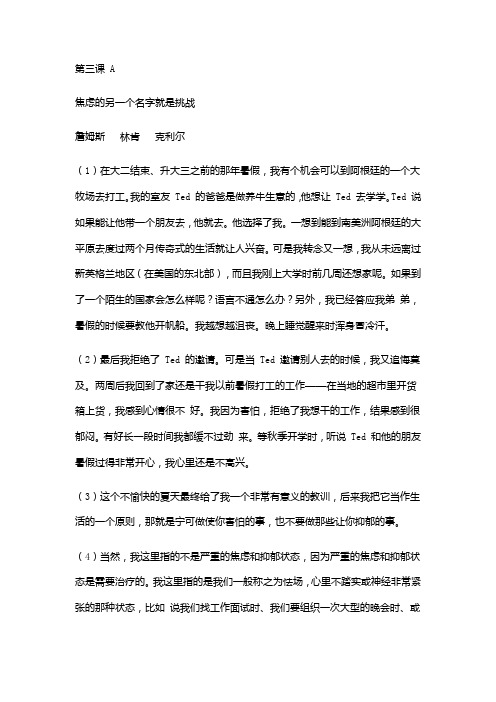
第三课 A焦虑的另一个名字就是挑战詹姆斯林肯克利尔(1)在大二结束、升大三之前的那年暑假,我有个机会可以到阿根廷的一个大牧场去打工。
我的室友 Ted 的爸爸是做养牛生意的,他想让 Ted 去学学。
Ted 说如果能让他带一个朋友去,他就去。
他选择了我。
一想到能到南美洲阿根廷的大平原去度过两个月传奇式的生活就让人兴奋。
可是我转念又一想,我从未远离过新英格兰地区(在美国的东北部),而且我刚上大学时前几周还想家呢。
如果到了一个陌生的国家会怎么样呢?语言不通怎么办?另外,我已经答应我弟弟,暑假的时候要教他开帆船。
我越想越沮丧。
晚上睡觉醒来时浑身冒冷汗。
(2)最后我拒绝了 Ted 的邀请。
可是当 Ted 邀请别人去的时候,我又追悔莫及。
两周后我回到了家还是干我以前暑假打工的工作——在当地的超市里开货箱上货,我感到心情很不好。
我因为害怕,拒绝了我想干的工作,结果感到很郁闷。
有好长一段时间我都缓不过劲来。
等秋季开学时,听说 Ted 和他的朋友暑假过得非常开心,我心里还是不高兴。
(3)这个不愉快的夏天最终给了我一个非常有意义的教训,后来我把它当作生活的一个原则,那就是宁可做使你害怕的事,也不要做那些让你抑郁的事。
(4)当然,我这里指的不是严重的焦虑和抑郁状态,因为严重的焦虑和抑郁状态是需要治疗的。
我这里指的是我们一般称之为怯场,心里不踏实或神经非常紧张的那种状态,比如说我们找工作面试时、我们要组织一次大型的晚会时、或我们必须在办公室做重要报告时的那种感觉。
我指的这种郁闷就是心情不好,感觉很沮丧,对什么事也不感兴趣,什么事也干不进去、也没精力去干。
(5)在我大学四年级快结束时,也遇到了这种情况。
因为毕业临近,我开始尝试考虑把写作作为我的终生职业。
但是我的一个教授极力劝我考研究生,目的是今后可以以教书为职业。
我踌躇了。
一想到以写作为生就使人感到害怕,我想比暑假到阿根廷大平原上打工还可怕。
我想来想去,做了决定又放弃。
突然我意识到每次我想放弃写作,心情都会特别沉重,很沮丧。
11、武大研究生英语期末考试英译汉重点句子

Unit oneStumbling block in intercultural communication1 在这个国际舞台发生重大变化的时刻,探讨为什么尝试交流的结果却令人失望的原因是必要的,这些原因实际上是跨文化交流中的绊脚石。
It’s appropriate at this time of major changes in the international scene to take a look at some of the disappointing results of attempts at communication. They are actually stumbling block in international communication.7 本国居民可能会被灌输有这种期望:既然外国人穿着合适,并且能说一些本国话,那么他或她也有同样的非语言的准则、想法和感觉。
The native inhabitants are likely to be lulled into the expectation that ,since the foreign person is dressed appropriately and speak some of the language,he or she will also have similar nonverbal codes ,thoughts and feelings.8 更糟糕的问题是死死抱住新语言中一个词汇或短语的一种意义,而不顾隐含义和语境。
A worse language problem is the tenacity with which someone will cling to just one meaning of a word or phrase in the new language, regardless of connotation or context.11 先入为主和程式化思维的现象第四个绊脚石是先入为主的观念和程式思维现象。
研究生英语课文原文加翻译学习上第1第2单元

研究生英语课文原文加翻译学习上第1第2单元Unit 101 Something in the American psyche loves new frontiers. We hanker after wide-open spaces; we like to explore; we like to make rules but refuse to follow them. But in this age it’s hard to find a place where you can go and be yourself without worrying about the neighbors.美国人的内心深处具有一种酷爱探索新领域的气质。
我们渴求宽敞的场地,我们喜欢探索,喜欢制定规章制度,却不愿去遵守。
在当今时代,却很难找到一块空间,可以供你任意驰骋,又不必担心影响你的邻居。
02 There is such a place: cyberspace. Formerly a playground for computer fans, cyberspace now embraces every conceivable constituency: schoolchildren, flirtatious singles, Hungarian-Americans, accountants. Can they all get along? Or will our fear of kids surfing for dirty pictures behind their bedroom doors provoke a crackdown?确实有这样一个空间,那就是信息空间。
这里原本是计算机迷的游戏天地,但如今只要想像得到的各类人群应有尽有,包括少年儿童、轻佻的单身汉、美籍匈牙利人、会计等。
问题是他们都能和睦相处吗?人们是否会因为害怕孩子们躲在卧室里看网上的淫秽图片而将它封杀?03 The first order of business is to grasp what cyberspace is. It might help to leave behind metaphors of highways and frontiers and to think instead of real estate.2 Real estate, remember, is an intellectual, legal, artificial environment constructed on top of land. Real estate recognizes the difference between parkland and shopping mall, between red-light zone3 and school district, between church, state and drugstore.首先要解决的问题是,什么是信息空间。
华中农大研究生B版英文课文翻译

1.真爱无限那是在1942年的一个寒冷而漆黑的冬天,与在纳粹集中营的其他日子里一样没有任何区别,在冬日里我裹着破布,瑟瑟发抖,依然无法相信这噩梦般的一切。
我只是一个年轻的男孩,我应该和朋友们一起玩耍,一起上学,憧憬美好的未来,长大,结婚,拥有一个属于我的家庭。
但是,对于眼前这一切来说,那些都是梦而已,我不再向往他们。
取而代之的是,我即将死去,自从我被从自己的家乡带到这来后,每天每小时都苟延残喘,我明天还会活着吗?是否今晚就会被带进毒气室呢?我在铁丝网附近来回走着,试图让瘦弱的身体暖和起来。
我很饿,已经记不起来何时有饥饿感了。
可以吃的东西似乎只是一个梦而已。
每一天,随着我们中人数的减少,那些过去的欢乐时间似乎仅仅是一场梦而已,于是我陷入了越来越深的绝望当中。
突然,我注意到,一个年轻的女孩正经过铁丝网的那端。
她停住脚步,用一双带有哀愁的目光看着我,似乎她也想告诉我,她理解我的处境,但是不晓得为何我会在这里。
我想把目光转移开,她这样看着我让我感到慕名奇妙的羞愧,但是,我又无法转移我的目光。
就在那时,她把手伸进口袋,拿出了一个红苹果,一个漂亮的,闪着红光的苹果。
啊,从我上次见到它已近很久很久了!她警惕的左右环视了一下,然后面带着胜利的微笑,将苹果扔过了铁丝网。
我跑过去捡起了苹果,用冻的发抖双手紧紧握住它。
在我死亡的世界里,这个苹果所传递出的的正是生命和爱。
我抬起头,注视着那个女孩消失在远处。
第二天,我无法控制住自己,在同一时间,来到了靠近栅栏的地方。
是我疯了,希望她能再次出现吗?当然,就在此处,我必须抓住任何微小的希望,因为她给了我希望,所以,我必须要牢牢抓紧它。
她真的再次来了,并且,再次给我带来了一个苹果,面带着微笑,将苹果扔过铁丝网。
这次,我接住了苹果,并且把它举起,以便能让那个女孩看到。
她的眼睛在闪烁,是在同情我吗?或许,但是,我不敢肯定。
我只是感到这样注视着她是如此的幸福。
第一次,时间是与此之长,我可以感到自己的心随着激情而起伏。
武汉大学研究生英语作业-My-ideas-about-Intercultural-Communica

My ideas about Intercultural Communication Communication exists everywhere,no matter what you do, you just can't avoid it. People give messages and get understand and have a exchange by languages,gestures and so on—-they are all communications。
People are born to communicate,though someone refuses to admit it。
Culture plays an important role in communication。
People from different cultures may have diverse thoughts, reactions which are influenced by their own culture profoundly。
As life changes with each passing day, people get more opportunities to communicate with foreigners, then problems appear——people can't catch every meaning precisely from each other, so attention is forced to be paid to intercultural communication。
We can infer from these days' studies:intercultural communication occurs when people from different cultures exchange verbal and nonverbal messages。
新编研究生英语系列教材英语课文翻译
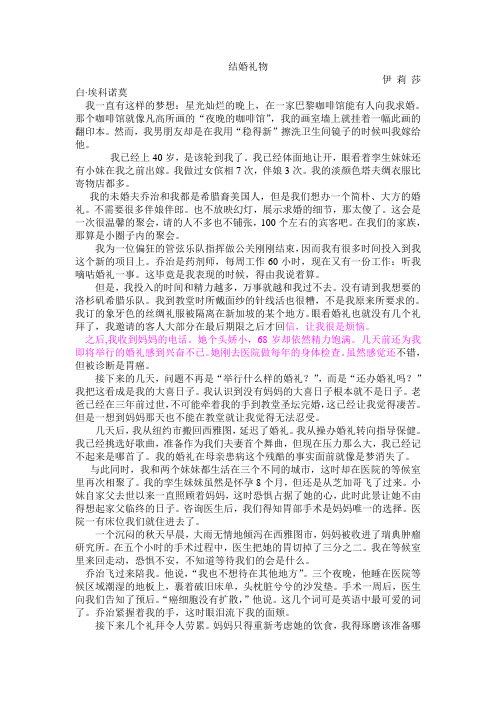
结婚礼物伊莉莎白∙埃科诺莫我一直有这样的梦想:星光灿烂的晚上,在一家巴黎咖啡馆能有人向我求婚。
那个咖啡馆就像凡高所画的“夜晚的咖啡馆”,我的画室墙上就挂着一幅此画的翻印本。
然而,我男朋友却是在我用“稳得新”擦洗卫生间镜子的时候叫我嫁给他。
我已经上40岁,是该轮到我了。
我已经体面地让开,眼看着孪生妹妹还有小妹在我之前出嫁。
我做过女傧相7次,伴娘3次。
我的淡颜色塔夫绸衣服比寄物店都多。
我的未婚夫乔治和我都是希腊裔美国人,但是我们想办一个简朴、大方的婚礼。
不需要很多伴娘伴郎。
也不放映幻灯,展示求婚的细节,那太傻了。
这会是一次很温馨的聚会,请的人不多也不铺张,100个左右的宾客吧。
在我们的家族,那算是小圈子内的聚会。
我为一位偏狂的管弦乐队指挥做公关刚刚结束,因而我有很多时间投入到我这个新的项目上。
乔治是药剂师,每周工作60小时,现在又有一份工作:听我嘀咕婚礼一事。
这毕竟是我表现的时候,得由我说着算。
但是,我投入的时间和精力越多,万事就越和我过不去。
没有请到我想要的洛杉矶希腊乐队。
我到教堂时所戴面纱的针线活也很糟,不是我原来所要求的。
我订的象牙色的丝绸礼服被隔离在新加坡的某个地方。
眼看婚礼也就没有几个礼拜了,我邀请的客人大部分在最后期限之后才回信,让我很是烦恼。
之后,我收到妈妈的电话。
她个头娇小,68岁却依然精力饱满。
几天前还为我即将举行的婚礼感到兴奋不已。
她刚去医院做每年的身体检查。
虽然感觉还不错,但被诊断是胃癌。
接下来的几天,问题不再是“举行什么样的婚礼?”,而是“还办婚礼吗?”我把这看成是我的大喜日子。
我认识到没有妈妈的大喜日子根本就不是日子。
老爸已经在三年前过世,不可能牵着我的手到教堂圣坛完婚,这已经让我觉得凄苦。
但是一想到妈妈那天也不能在教堂就让我觉得无法忍受。
几天后,我从纽约市搬回西雅图,延迟了婚礼。
我从操办婚礼转向指导保健。
我已经挑选好歌曲,准备作为我们夫妻首个舞曲,但现在压力那么大,我已经记不起来是哪首了。
武汉大学研究生英语Unit 7 考试难句翻译

1.It was a big, frame squarish house that had once been white, decorated with cupolas and spires and scrolled balconies in the heavily lightsome style of the seventies, set on what had once been our most select street. (Para 2)那是一幢过去漆成白色的四方形大木屋,坐落在当年一条最考究的街道上,还装点着有十九世纪七十年代风格的圆形屋顶,尖塔和涡形花纹的阳台,带有浓厚的轻盈气息2.only Miss Emily's house was left, lifting its stubborn and coquettish decay above the cotton wagons and the gasoline pumps 一an eyesore among eyesores. (Para 2)只有爱米丽小姐的屋子岿然独存,四周簇拥着棉花车和汽油泵.房子虽已破败,却还是桀骜不驯,装模作样,真是丑中之丑.3.Colonel Sartoris invented an involved tale to the effect that Miss Emily’s father had loaned money to the town, which the town, as a matter of business, preferred this way of repaying. (Para 3)沙多里斯上校编造了一大套无中生有的话,说是爱米丽的父亲曾经贷款给镇政府,因此,镇政府作为一种交易,宁愿以这种方式偿还.4.When the Negro opened the blinds of one window, they could see that the leather was cracked;and when they sat down, a faint dust rose sluggishly about their thighs, spinning with slow motes in the single sun-ray.(Para 5)黑人掀开一扇窗帘,这时,便可看出皮套子已经坼裂;等他们坐了下来,大腿两边就有一阵灰尘冉冉上升,尘粒在那一缕阳光中缓缓旋转.5.Her skeleton was small and spare; Perhaps that was why what would have been merely plumpness in another was obesity in her: Because of her small frame, extra weight became much more visible and exaggerated on her. (Para 6)她的身架矮小,也许正因为这个缘故,在别的女人身上显得是丰满的东西,而她却给人以肥大的感觉.6.Her eyes, lost in the fatty ridges of her face, looked like two small pieces of coal pressed into a lump of dough as they moved from one face to another while the visitors stated their errand. (Para 6)当客人说明来意时,她那双凹陷在一脸隆起的肥肉之中,活像揉在一团生面中的两个小煤球似的眼睛不住地移动着,时而瞧瞧这张面孔,时而打量那张面孔。
研究生公共英语第五版课文译文-特全
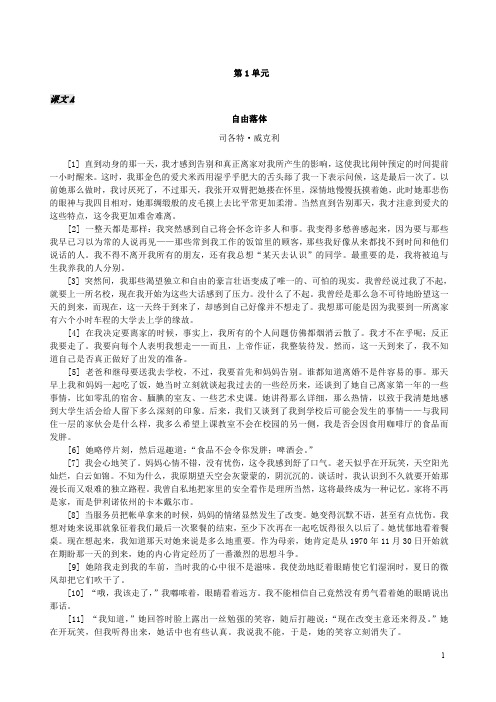
第1单元课文A自由落体司各特·威克利[1]直到动身的那一天,我才感到告别和真正离家对我所产生的影响,这使我比闹钟预定的时间提前一小时醒来。
这时,我那金色的爱犬米西用湿乎乎肥大的舌头舔了我一下表示问候,这是最后一次了。
以前她那么做时,我讨厌死了,不过那天,我张开双臂把她搂在怀里,深情地慢慢抚摸着她,此时她那悲伤的眼神与我四目相对,她那绸缎般的皮毛摸上去比平常更加柔滑。
当然直到告别那天,我才注意到爱犬的这些特点,这令我更加难舍难离。
[2]一整天都是那样:我突然感到自己将会怀念许多人和事。
我变得多愁善感起来,因为要与那些我早已习以为常的人说再见——那些常到我工作的饭馆里的顾客,那些我好像从来都找不到时间和他们说话的人。
我不得不离开我所有的朋友,还有我总想“某天去认识”的同学。
最重要的是,我将被迫与生我养我的人分别。
[3]突然间,我那些渴望独立和自由的豪言壮语变成了唯一的、可怕的现实。
我曾经说过我了不起,就要上一所名校,现在我开始为这些大话感到了压力。
没什么了不起。
我曾经是那么急不可待地盼望这一天的到来,而现在,这一天终于到来了,却感到自己好像并不想走了。
我想那可能是因为我要到一所离家有六个小时车程的大学去上学的缘故。
[4]在我决定要离家的时候,事实上,我所有的个人问题仿佛都烟消云散了。
我才不在乎呢;反正我要走了。
我要向每个人表明我想走——而且,上帝作证,我整装待发。
然而,这一天到来了,我不知道自己是否真正做好了出发的准备。
[5]老爸和继母要送我去学校,不过,我要首先和妈妈告别。
谁都知道离婚不是件容易的事。
那天早上我和妈妈一起吃了饭,她当时立刻就谈起我过去的一些经历来,还谈到了她自己离家第一年的一些事情,比如零乱的宿舍、腼腆的室友、一些艺术史课。
她讲得那么详细,那么热情,以致于我清楚地感到大学生活会给人留下多么深刻的印象。
后来,我们又谈到了我到学校后可能会发生的事情——与我同住一层的家伙会是什么样,我多么希望上课教室不会在校园的另一侧,我是否会因食用咖啡厅的食品而发胖。
武汉理工大学研究生英语Units-1-8课后习题答案及课文翻译

Unit1SchoolingPassageOneVocabulary1.striking2.slenderimpeccable3.discernible4.sloppy5.sagacity6.arrogance7.vow8.homonym9.glistening10.fixtheblameonPassageTwoVocabulary1.A2.B3.C4.A5.B6.D7.A8.D9.D10.CTranslation1.我曾经遇到过这样一位管弦乐指挥严师。
当有人弹错时,他怒骂他为白痴”;当有人弹走音时,他暂停指挥,怒吼。
他就是杰瑞·卡帕琪斯基——乌克兰移民。
2.传统的观念认为老师应该为学生梳理知识,而不是一味的把知识塞进他们的脑袋里。
作业和小组学习都是备受青睐的学习手段。
传统的方法,如讲授和背诵,都被讥讽为“钻杀”,被人反对,被贬为是用正确的方法来蚕食年轻一代的创造力和积极性。
3.死记硬背现在被作为解释来自印度(印度人的记忆力让人赞不绝口)家庭的孩子在全国拼字比赛中大胜对手的一个原因。
4.当然,我们也担心失败会给孩子造成精神创伤,削弱他们的自尊。
5.研究人员曾以为,最有效的老师会通过小组学习和讨论带领学生学习知识。
PassageOne马文科林斯的方法在人群中,马文老师总是会显得很醒目:她有着高高的颧骨,瘦而强健,这都遗传自她那乔克托印第安人血统的曾祖母。
马文老师瘦削而不柔弱,就算她没有那么高,在人群中时还是一眼就能识别出来——因为她有着特别的镇静及教养,这些都使她有了一种严谨的风格。
马文很少穿宽松衣服,也决不穿宽大的直筒连衣裙或不正式的短衫及裙子。
马文认为宽大的衣服是对自己、对学生、对教师这一职业的不敬。
从开学的第一天起,马文老师总会告诉设法让孩子们懂得:自尊是一个人最可宝贵的东西。
马文的着装总是无可挑剔,这既是为了自己,也是为了学生们:她爱穿开司米羊毛衫、套装以及人字形花呢服装。
她的衣服都剪裁得很合适,时髦而简单,但她常常会加上一个装饰品:在羊毛衫上配上一条雕有花纹的腰带,或一条有圆形浮雕的锁链,或玻璃纱襟花,抑或是一块用狮头胸针别在口袋上的花边手巾。
武汉大学博士英语课文电子版

Unit-3 Adam Smith Right and Wrong1 Even though more than 200 years have passed and the world has changed radically, a version of Adam Smith’s ideas is revered by millions of prosperous and influential individuals who don’t know what Smith’s ideas were. Jerry Z. Muller’s book is an exercise in historical excavation and as an excavator he succeeds very well. But I am dubious about Muller’s claim that Smith is still the most cogent defender of capitalism. Too much has changed in the last 200 years for that to be the case. He---Muller---must be absolved from responsibility for the opinions expressed here; they are mine, not his.2 We start with the excavation of the first of Adam Smith’s two books, The Theory of Moral Sentiments, published in 1759, to Smith’ s evident dissatisfaction, since he revised it six times until his death in 1790. The subject is the unraveling of a mystery: What holds society together? Why do innately self-seeking humans usually act decently to one another? Our credulity is strained to think that the fear of punishment explains it all. The question is nothing less than the origin of morality.3 Smith observed that each normal person is born with the capacity to imagine how it feels to be in someone else’ s place. He or she feels a need for the approval of others. This need is directly related to the passion (as Smith called it) to seek one’ s self-interest. A normal child learns to mold his behavior in a way that will win recognition and approval and avoid scorn and disapproval. The molding starts in the family, extends to the neighborhood, church, and school, and ultimately to the wider society.4 In the course of this tutelage, a human being internalizes social norms develops a conscience---an impartial observer--- which is able to measure the behavior of the person observing himself and the behavior of others by the same standards. A social being emerges from this hitherto mysterious process, as one who possesses self-command, who is able to rule his or her own passions and thus be fit to live with others.5 Some indeterminate number of men and women, due to exceptional endowments or circumstance, are able to take a further step and, rather than guiding their actions according to the praise of others, guide them by standards they themselves consider praiseworthy. Among these moral exemplars is a small party concerned with improving the institutions that serve the general interest. As man of the Enlightenment who placed hope in the power of reason to sweep unreason before it, Smith looked to this small party to gain the attention of statesmen and in due time en lighten them. In this capacity he himself was unexcelled.6 There is a strange here. Smith believed that it was not reason that ruled but human passions. Yet it was necessary for reason to discover and support the institutions that directed the passions to universally beneficial ends to be said about this as long as we keep clearly in mind whether the subject is the invisible hand or the visible hand.7 The only question that Smith could not answer was: Why people are moral, other thanassuming that God made us that way. In The Descent of Man (1871), Charles Darwin provide the most widely accepted explanation: Cooperation is adaptive in social species; cognitively advanced social species take pleasure in the company of others and language gives Homo sapiens the ability to generalize from shared experiences about fairness and duty. This degree of intelligence makes it possible to extend moral behavior from kin to non-kin; to a village, a religion, a class, a nation, or the entire world. The history of social institutions, a subject on which Smith wrote with erudition, shows that exclusion or inclusion of those for whom we feel moral sentiments is not fixed once and for all but depends on how we define “us and them”. Nothing in Darwin contradicts Smith.8 We can be sure that Smith was aware of this issue because of his comments on the conflict between the British establishment and the American colonies, about which he learned a great deal from his friend Benjamin Franklin. Smith considered taxation of the colonists without representation in Parliament to be folly. The outcome leaves no doubt that Smith knew moral sentiments cannot survive the effects of alienation.9 Now we come to Jerry Z. Muller’s excavation of Adam Smith’s great unread book, The Wealth of Nations, published in 1776. Many readers may think this excavation unnecessary, the ideas of that treatise being so well known. Perhaps. The invisible hand ranks as one of the most successful academic metaphors of all time. In the market, people are strangers to one another. They may be acquainted or even friendly. But their interests are opposed. Self-interest rather than moral interest prevail except on the rules of the game: no coercion, fraud, contracting away third parties’ rights, and so forth. But the single-minded pursuit of self-interest nevertheless results in the general good, as we all know, because free competition forces prices to the lowest level compatible with the costs of land, labor, and capital. It induces enterprisers to move their resources out of markets where supply exceeds demand into markets where demand exceeds supply, so that the goods and services they produce correspond to the wants of consumers. No one planned these results, and no one intended them to come to pass: free competition is self-regulating.10 The mercantilists, against whom Smith polemicized, believed that the wealth of nations depended on the accumulation of gold and silver obtained by countries which export more than they import, a result enhanced by monopolies in trade bestowed by the state. The rise in the standard of living during the 18th century underlined Smith’s counter-argument that the wealth of nations depends on the growth of the market, which encourages an increasing division of labor, more specialization, and consequently greater productivity. Monopolies increase the wealth of monopolies; free competition increases the wealth of the entire country.11 Many of Smith’s present-day epigones, who have not followed Professor Muller’s excavation deeper, conclude that Smith was a particular friend of business. He was not. He scorned the frequent practice of merchants who conspire behind closed doors to raise prices and depress wages, and warned that they bear watching. He was no more a friend of workers, who combined to raise wages, although he recognized that the repetitiveness of manufacturing jobs made factory hands as dull as they possibly could be. But he expected the salutary effects of commerce to raise wages in the long run, increase leisure time, and create revenues for publicelementary education to offset the misery of simple-minded, numbing work.12 Dose Sm ith’s championship of free markets mean that he was hostile to the state? It does not. He expected the responsibilities and size of the state to grow as commercial society grew and the revenues of the state to increase commensurately, contrary to the views of his modern apostles. The state must spend for defense; for public works; for the enforcement of law; for public education; and for creating a structure to protect every member of society from the oppression of every other member by, as he wrote, “promo ting the prosperity of the commonwealth, by establishing good discipline, and by discouraging every sort of vice and impropriety; it may prescribe rules, therefore which not only prohibit mutual injuries among fellow-citizens, but command mutual good offic es to a certain degree ”(quoted on p.148).13 But Smith had no illusions about the impartiality of government. He did not trust the landowners, the capitalists, or the workers. He recognized that laws reflect the power of those who make them and codify the shared standards of the dominant orders of society. Universal suffrage was not ever a topic of conversation, and deference to the higher orders was taken for granted.14 Like most men of the Enlightenment, he was dazzled by Newton’s model of a self-regulating universe, which astonished the world in 1687, an used it as an inspiration to create a self-regulating social universe where class power is controlled by an invisible hand much as the heavenly bodies are controlled by gravity.15 Looking back, we can see that Smith was both right and wrong. He was right about the power of moral sentiments in civilizing society, but he knew the limits to the impartiality of the impartial observer an he knew that moral sentiments stop at many borders unless the strongest incentives exist to extend them.16 He was right about the effectiveness of the free market in prodigiously increasing the wealth of nations, but he knew that men were constantly trying to find ways to circumvent it. He could know nothing lf the inventions that brought about the Industrial Revolution, the huge concentrations of business, the emergence of trade unions, the periodic waves of unemployment, and the “bads” produced along with the “goods”, externalities as Arthur Pigou called t hem, the costs of which had to be paid by somebody. With all these exacerbating tensions of the 19th and 20th centuries, it was too much to expect that lawmakers, prime ministers, and presidents could understand, much less agree on, how to contain this explosive mixture.17 Almost everything that could go wrong with Smith’s civilizing project did go wrong. We can no more expect Smith to be right about the 200 years between his time and ours than we can expect ourselves to be right about the next 200 ye ars. The great problem with Smith’s system is that it is driven down the middle by two invisible hands at war with one another. One invisible hand guides the moral sentiments of civil society; the other guides the self-interest of commercial society. And many visible hands are grasping at their wrists to turn them in this direction or that. The two invisible hands are ghostly apparitions of two spheres they represent: the capitalist market and the civil society. The separation of the two is the fatal flaw of modern conservatism. How tobring morality into the market is the central issue of capitalism.18 As I said at the beginning, Smith is not the most cogent defender of capitalism; we live ina different capitalism; If I wanted to sketch a defense of modern capitalism, and it is the only practical thing to do, I would start with the fact that we live in a society of conflicting interests, and that the only alternative to going to hell together is compromise between the conflicting interests. The best defense of modern capitalism is a social contract between the two classes of markedly unequal power. Only the reorganization of countervailing power by labor and its supporters can lead to a compromise of mutual benefit.19 I say reorganization because countervailing power and a social contract exist after World WarⅡ. But in the last 25 years Europe and we have decivilized into high unemployment, rising poverty, and an increasingly unequal distribution of income.20 I am describing a possible capitalism, one where there is concurrence in minimum standards of life for all and concern for the common good. Those who write about the free market as being triumphant and social democracy being left in the dust are premature. A one-class society—pluralistic, democratic, with common rather than antagonistic interests: let us not be too hasty to say finis, as the present situation becomes increasingly unteriable.21 The greatest unforeseen and unintended consequence of Adam Smith’s doctrine is its use as an ideology of the privileged. His means are naively or hypocritically supported, for we have no free market in the sense that Smith defined it. But the ends of fairness for which he proposed the means are ignored.22 We have it on the authority of Sir Walter Scott that when Adam Smith and Samuel Johnson first met, they fell into an argument, with Johnson saying to Smith, “You lie?” and Smith replying: “You are a son of bitch!” This colloquy seems out of character, since Smith was widely respected for his learning and humanity by contemporaries as diverse as Edmund Burke and V oltaire, both of whom he counted as friends. But it does give us an idea of what he would have to say to some of his present-day admirers.。
武汉大学研究生英语unit1、3、4、5、7原文及译文

Unit One stumbling blocks in intercultural communication跨文化交流中的绊脚石1.为什么我们与来自其它文化的人们的交流总是充满了误会、让人感到沮丧呢?令很多人奇怪的是,即使怀着良好的愿望、使用自己认为是友好的方式,甚至有互利的可能性,也似乎都不足以保证交流的成功。
有时候,出现排斥现象正是因为一方所属的文化群体团体是“不同”的。
在这个国际舞台发生重大变化的时刻,探讨为什么尝试交流的结果却令人失望的原因是必要的,这些原因实际上是跨文化交流中的绊脚石。
2.相似性的假设为什么误解或反对会产生呢?这个问题的一个回答就是,大部分的人天真地认为世界上的人有足够的相似之处,可以让我们成功地交流信息或感受,解决共同关注的一些问题,加强商业关系,或者只是产生我们所希望产生的印象。
所有的人都会生儿育女,组成家庭或社会,发展一种语言以及适应他们周围环境的这种倾向特别具有欺骗性,因为它带来了一种期望,这种期望就是这些行为的形式以及围绕这些行动的态度与价值观念将是相似的。
相信“人就是人”和“我们内在本质是相似的,”这让人感到心安理得,但是下定决心去寻找证据却只会令人失望。
3.力求证明达尔文关于面部表情是共同的这一理论的跨文化研究给人极大的希望,研究者发现脸部的某些看得见的形状,即因愤怒、恐惧、惊讶、悲伤、厌恶、幸福而紧缩的肌肉组合,我们人类各成员都是一样的。
但是这似乎无济于事,只要我们意识到一个人生长的文化决定了这种情感是否会表露或压抑,决定了在何种场合和多大的程度上会表露或压抑。
带来这种情绪感受的情形也因文化而异,例如:由于崇拜的文化信仰不同,一个心爱的人死亡可能带来欢乐、悲哀或其他情感。
4.因为似乎没有普遍的人性可以作为自动理解的基础,所以我们必须把每交往当作个别案例来处理,寻求任何共同的认知和交流方法并以此作为出发点。
如果我们认识到我们受文化的约束,受文化的改变,那么我们就会受这一现实:因为各自不同,我们确实不太清楚其他人“是”什么样的。
武汉大学研究生英语听力原文整理
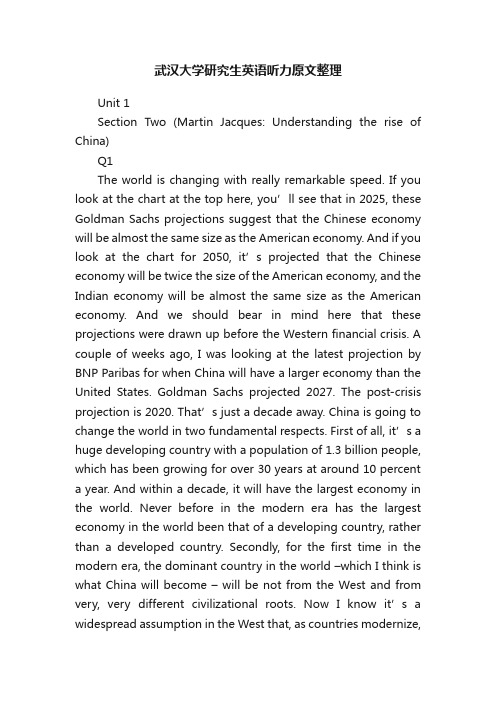
武汉大学研究生英语听力原文整理Unit 1Section Two (Martin Jacques: Understanding the rise of China)Q1The world is changing with really remarkable speed. If you look at the chart at the top here, you’ll see that in 2025, these Goldman Sachs projections suggest that the Chinese economy will be almost the same size as the American economy. And if you look at the chart for 2050, it’s projected that the Chinese economy will be twice the size of the American economy, and the Indian economy will be almost the same size as the American economy. And we should bear in mind here that these projections were drawn up before the Western financial crisis. A couple of weeks ago, I was looking at the latest projection by BNP Paribas for when China will have a larger economy than the United States. Goldman Sachs projected 2027. The post-crisis projection is 2020. That’s just a decade away. China is going to change the world in two fundamental respects. First of all, it’s a huge developing country with a population of 1.3 billion people, which has been growing for over 30 years at around 10 percent a year. And within a decade, it will have the largest economy in the world. Never before in the modern era has the largest economy in the world been that of a developing country, rather than a developed country. Secondly, for the first time in the modern era, the dominant country in the world –which I think is what China will become – will be not from the West and from very, very different civilizational roots. Now I know it’s a widespread assumption in the West that, as countries modernize,they also Westernize. This is an illusion. It’s an assumption that modernity is a product simply of competition, markets and technology. It is not; it is also shaped equally by history and culture. China is not like the West, and it will not become like the West. It will remain in very fundamental respects very different. Now the big question here is obviously, how do we make sense of China? How do we try to understand what China is? And the problem we have in the West at the moment by-and-large is that the conventional approach is that we understand it really in Western terms, using Western ideas. We can’t. Now I want to offer you three building blocks for trying to understand what China is like – just as a beginning.世界正以惊人的速度变化着。
研究生科技英语阅读课文及译文第四章
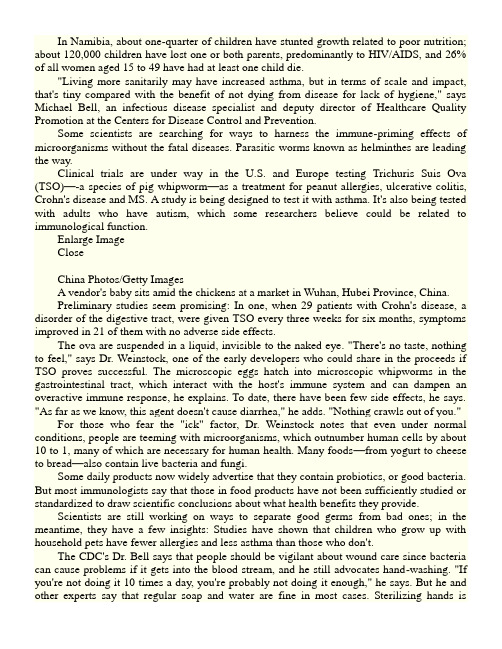
In Namibia, about one-quarter of children have stunted growth related to poor nutrition; about 120,000 children have lost one or both parents, predominantly to HIV/AIDS, and 26% of all women aged 15 to 49 have had at least one child die."Living more sanitarily may have increased asthma, but in terms of scale and impact, that's tiny compared with the benefit of not dying from disease for lack of hygiene," says Michael Bell, an infectious disease specialist and deputy director of Healthcare Quality Promotion at the Centers for Disease Control and Prevention.Some scientists are searching for ways to harness the immune-priming effects of microorganisms without the fatal diseases. Parasitic worms known as helminthes are leading the way.Clinical trials are under way in the U.S. and Europe testing Trichuris Suis Ova (TSO)—-a species of pig whipworm—as a treatment for peanut allergies, ulcerative colitis, Crohn's disease and MS. A study is being designed to test it with asthma. It's also being tested with adults who have autism, which some researchers believe could be related to immunological function.Enlarge ImageCloseChina Photos/Getty ImagesA vendor's baby sits amid the chickens at a market in Wuhan, Hubei Province, China.Preliminary studies seem promising: In one, when 29 patients with Crohn's disease, a disorder of the digestive tract, were given TSO every three weeks for six months, symptoms improved in 21 of them with no adverse side effects.The ova are suspended in a liquid, invisible to the naked eye. "There's no taste, nothing to feel," says Dr. Weinstock, one of the early developers who could share in the proceeds if TSO proves successful. The microscopic eggs hatch into microscopic whipworms in the gastrointestinal tract, which interact with the host's immune system and can dampen an overactive immune response, he explains. To date, there have been few side effects, he says. "As far as we know, this agent doesn't cause diarrhea," he adds. "Nothing crawls out of you."For those who fear the "ick" factor, Dr. Weinstock notes that even under normal conditions, people are teeming with microorganisms, which outnumber human cells by about 10 to 1, many of which are necessary for human health. Many foods—from yogurt to cheese to bread—also contain live bacteria and fungi.Some daily products now widely advertise that they contain probiotics, or good bacteria. But most immunologists say that those in food products have not been sufficiently studied or standardized to draw scientific conclusions about what health benefits they provide.Scientists are still working on ways to separate good germs from bad ones; in the meantime, they have a few insights: Studies have shown that children who grow up with household pets have fewer allergies and less asthma than those who don't.The CDC's Dr. Bell says that people should be vigilant about wound care since bacteria can cause problems if it gets into the blood stream, and he still advocates hand-washing. "If you're not doing it 10 times a day, you're probably not doing it enough," he says. But he and other experts say that regular soap and water are fine in most cases. Sterilizing hands iscritical mainly for health-care workers and in hospitals, where disease-causing germs are prevalent and can easily spread.Many experts advise common sense. "We don't want to say to children, 'OK, play by the dirty river bank and catch whatever you can,' " says Dr. Weinstock. "But we can say there's nothing wrong with kids playing in the dirt. They don't have to live in total sanitation, and they won't die from eating something off the floor. It's probably more healthy than not."All you need is a wormhole, the Large Hadron Collider or a rocket that goes really, really fast1 Hello. My name is Stephen Hawking. Physicist, cosmologist and something of a dreamer. Although I cannot move and I have to speak through a computer, in my mind I am free. Free to explore the universe and ask the big questions, such as: is time travel possible? Can we open a portal to the past or find a shortcut to the future? Can we ultimately use the laws of nature to become masters of time itself?1' Time travel was once considered scientific heresy. I used to avoid talking about it for fear of being labelled a crank. But these days I'm not so cautious. In fact, I'm more like the people who built Stonehenge. I'm obsessed by time. If I had a time machine I'd visit Marilyn Monroe in her prime or drop in on Galileo as he turned his telescope to the heavens. Perhaps I'd even travel to the end of the universe to find out how our whole cosmic story ends.2 To see how this might be possible, we need to look at time as physicists do - at the fourth dimension. It's not as hard as it sounds. Every attentive schoolchild knows that all physical objects, even me in my chair, exist in three dimensions. Everything has a width and a height and a length.3 But there is another kind of length, a length in time. While a human may survive for 80 years, the stones at Stonehenge, for instance, have stood around for thousands of years. And the solar system will last for billions of years. Everything has a length in time as well as space. Travelling in time means travelling through this fourth dimension.4 To see what that means, let's imagine we're doing a bit of normal, everyday car travel. Drive in a straight line and you're travelling in one dimension. Turn right or left and you add the second dimension. Drive up or down a twisty mountain road and that adds height, so that's travelling in all three dimensions. But how on Earth do we travel in time? How do we find a path through the fourth dimension?5 Let's indulge in a little science fiction for a moment. Time travel movies often feature a vast, energy-hungry machine. The machine creates a path through the fourth dimension, a tunnel through time. A time traveller, a brave, perhaps foolhardy individual, prepared for who knows what, steps into the time tunnel and emerges who knows when. The concept may be far-fetched, and the reality may be very different from this, but the idea itself is not so crazy.6 Physicists have been thinking about tunnels in time too, but we come at it from a different angle. We wonder if portals to the past or the future could ever be possible within the laws of nature. As it turns out, we think they are. What's more, we've even given them a name: wormholes. The truth is that wormholes are all around us, only they're too small to see. Wormholes are very tiny. They occur in nooks and crannies in space and time. You might find it a tough concept, but stay with me.6' A wormhole is a theoretical 'tunnel' or shortcut, predicted by Einstein's theory of relativity, that links two places in space-time - visualised above as the contours of a 3-D map, where negative energy pulls space and time into the mouth of a tunnel, emerging in another universe. They remain only hypothetical, as obviously nobody has ever seen one, but have been used infilms as conduits for time travel - in Stargate (1994), for example, involving gated tunnels between universes, and in Time Bandits (1981), where their locations are shown on a celestial map7 Nothing is flat or solid. If you look closely enough at anything you'll find holes and wrinkles in it. It's a basic physical principle, and it even applies to time. Even something as smooth as a pool ball has tiny crevices, wrinkles and voids. Now it's easy to show that this is true in the first three dimensions. But trust me, it's also true of the fourth dimension. There are tiny crevices, wrinkles and voids in time. Down at the smallest of scales, smaller even than molecules, smaller than atoms, we get to a place called the quantum foam. This is where wormholes exist. Tiny tunnels or shortcuts through space and time constantly form, disappear, and reform within this quantum world. And they actually link two separate places and two different times.8 Unfortunately, these real-life time tunnels are just a billion-trillion-trillionths of a centimetre across. Way too small for a human to pass through - but here's where the notion of wormhole time machines is leading. Some scientists think it may be possible to capture a wormhole and enlarge it many trillions of times to make it big enough for a human or even a spaceship to enter.9 Given enough power and advanced technology, perhaps a giant wormhole could even be constructed in space. I'm not saying it can be done, but if it could be, it would be a truly remarkable device. One end could be here near Earth, and the other far, far away, near some distant planet.10 Theoretically, a time tunnel or wormhole could do even more than take us to other planets. If both ends were in the same place, and separated by time instead of distance, a ship could fly in and come out still near Earth, but in the distant past. Maybe dinosaurs would witness the ship coming in for a landing.11 The fastest manned vehicle in history was Apollo 10. It reached 25,000mph. But to travel in time we'll have to go more than 2,000 times faster12 Now, I realise that thinking in four dimensions is not easy, and that wormholes are a tricky concept to wrap your head around, but hang in there. I've thought up a simple experiment that could reveal if human time travel through a wormhole is possible now, or even in the future. I like simple experiments, and champagne.12' So I've combined two of my favourite things to see if time travel from the future to the past is possible.Let's imagine I'm throwing a party, a welcome reception for future time travellers. But there's a twist. I'm not letting anyone know about it until after the party has happened. I've drawn up an invitation giving the exact coordinates in time and space. I am hoping copies of it, in one form or another, will be around for many thousands of years. Maybe one day someone living in the future will find the information on the invitation and use a wormhole time machine to come back to my party, proving that time travel will, one day, be possible.In the meantime, my time traveller guests should be arriving any moment now. Five, four, three, two, one. But as I say this, no one has arrived. What a shame. I was hoping at least a future Miss Universe was going to step through the door. So why didn't the experiment work? One of the reasons might be because of a well-known problem with time travel to the past, the problem of what we call paradoxes.Paradoxes are fun to think about. The most famous one is usually called the Grandfather paradox. I have a new, simpler version I call the Mad Scientist paradox.13 I don't like the way scientists in movies are often described as mad, but in this case, it's true. This chap is determined to create a paradox, even if it costs him his life. Imagine, somehow, he's built a wormhole, a time tunnel that stretches just one minute into the past. Hawking in a scene from Star Trek with dinner guests from the past, and future: (from left) Albert Einstein, Data and Isaac Newton14 Through the wormhole, the scientist can see himself as he was one minute ago. But what if our scientist uses the wormhole to shoot his earlier self? He's now dead. So who fired the shot? It's a paradox. It just doesn't make sense. It's the sort of situation that gives cosmologists nightmares.15 This kind of time machine would violate a fundamental rule that governs the entire universe - that causes happen before effects, and never the other way around. I believe things can't make themselves impossible. If they could then there'd be nothing to stop the whole universe from descending into chaos. So I think something will always happen that prevents the paradox. Somehow there must be a reason why our scientist will never find himself in a situation where he could shoot himself. And in this case, I'm sorry to say, the wormhole itself is the problem.16 In the end, I think a wormhole like this one can't exist. And the reason for that is feedback. If you've ever been to a rock gig, you'll probably recognise this screeching noise. It's feedback. What causes it is simple. Sound enters the microphone. It's transmitted along the wires, made louder by the amplifier, and comes out at the speakers. But if too much of the sound from the speakers goes back into the mic it goes around and around in a loop getting louder each time. If no one stops it, feedback can destroy the sound system.17 The same thing will happen with a wormhole, only with radiation instead of sound. As soon as the wormhole expands, natural radiation will enter it, and end up in a loop. The feedback will become so strong it destroys the wormhole. So although tiny wormholes do exist, and it may be possible to inflate one some day, it won't last long enough to be of use asa time machine. That's the real reason no one could come back in time to my party.18 Any kind of time travel to the past through wormholes or any other method is probably impossible, otherwise paradoxes would occur. So sadly, it looks like time travel to the past is never going to happen. A disappointment for dinosaur hunters and a relief for historians.虫洞是根据爱因斯坦相对论预测的连接时空中两个不同地点的假想“隧道”或捷径,上面的三维图轮廓集中呈现了这一点:负能量将时间和空间拖入一条隧道入口,并在另一个宇宙出现。
- 1、下载文档前请自行甄别文档内容的完整性,平台不提供额外的编辑、内容补充、找答案等附加服务。
- 2、"仅部分预览"的文档,不可在线预览部分如存在完整性等问题,可反馈申请退款(可完整预览的文档不适用该条件!)。
- 3、如文档侵犯您的权益,请联系客服反馈,我们会尽快为您处理(人工客服工作时间:9:00-18:30)。
武汉大学研究生英语课文原文 Stumbling Blocks inInterculturalStumbling Blocks inIntercultural Communication1. Why is it that contact with persons from other cultures is so often frustrating and fraught with misunderstanding? Good intentions, the use of what one considers to be a friendly approach and even the possibility of mutual benefits don't seem to be sufficient to ensure success-to many people's surprise. Sometimes rejection occurs just because the group to which a person belongs is\changes in the international scene to take a look at some of the reasons for the disappointing results of attempts at communication. They are actually stumbling blocks in intercultural communication.2. Assumption of similaritiesOne answer to the question of why misunderstanding or rejection happens might be that many of us naivety assume there are sufficient similarities among peoples of the world to enable us tosuccessfully exchange information or feelings, solve problems ofmutual concerns, cement business relationships, or just make the kind of impression we wish to make. The tendency for all peopleto reproduce, group into families or societies, develop a language, and adapt to their environment is particularly deceiving because it leads to the expectation that the forms of these behaviors and the attitudes and values surrounding them will also besimilar. It's comforting to believe that\we'reall alike,\a determined search for proof of this leads to disappointment.3. Promising are the cross-cultural studies seeking to supportDarwin's theory that facial expressions are universal and researchers found that theparticular visible pattern on the face, the combination of muscles contracted for anger, fear, surprise, sadness, disgust, and happiness is the same for allmembers of ourspecies, but this seems helpful until it is realized that a person’s cultu ral upbringing determines whether or notthat emotionwill be displayed or suppressed, as well as on which occasions and to what degree. The situations that bring about the emotional feeling also differ from culture to culture, for example, the death of a loved one may be a cause forjoy, sorrow, or some other emotion, depending upon the accepted cultural belief.4. Since there seems to be no universals of “human nature” that can be used as a basis for automatic understanding, we must treat each encounter as an individual case, searching for whatever perceptions and communication means are held in common and proceed from there. If we realize that we are all culture bound andculturally modified, we will accept the fact that, being unlike, wedo not reallyknow what someone else\5. The aura of similarity is a serious stumbling block to successful intercultural communication. A look-alike facade is deceiving when representatives from contrasting cultures meet, eachwearing Western dress, speaking English, and using similar greeting rituals. It is like assuming that New York, Tokyo, and Tehran are all alike because each has the appearance of a moderncity. Without being alert to possible differences and the needto learn new rules for functioning, persons going from one city tothe other will be in immediatetrouble, even when acting simple roles such as pedestrian and driver.6. Theconfidence that goes with the myth of similarity is much more comfortable than the assumption of differences, the latter requiring tentative assumptions and behaviors and a willingness toaccept the anxietyof\knowing.\with the assumptionof differences, however, can reactionsandinterpretationsbeadjustedtofit\happening.\someone is likely tomisread signs and judge the sceneethnocentrically.7. The stumbling block of assumedsimilarity is a “troublem,”as one English learner expressed it, not only for the foreigner but for the people in the host country with whom the internationalvisitor comes into contact. The native inhabitants are likely to be lulled into the expectation that, since the foreign person isdressed appropriately and speak some of the language, heor she will also have similar nonverbal codes, thoughts and feelings. Thus, nodding, smiling, and affirmative comment will probably be confidentlyinterpreted as meaning that they have informed,helped, and pleased the newcomer. It is likely, however, that theforeigner actually understood very little of the verbal and nonverbal content and was merely indicating polite interest or trying not to embarrass himself or herself of the host with verbalized questions. 8. Language DifferenceThe second stumbling block is so obvious that it hardly needs mentioning--language. Vocabulary, syntax, idioms, slang, dialects, and so on all cause difficulty, but the person strugglingwith a different language is at least aware of being in this kind oftrouble. A worse language problem is thetenacity with whichsomeone will cling to just one meaning of a word or phrase in thenew language, regardless of connotation or context. The variations in possible meaning, especially if inflection and tonal qualities are added, are so difficult to cope with that they are oftenwaved aside. The reason this problem is worse than simple struggling to translate foreign words is because each person thinks heor she understands. The nationwide misinterpretation of Khrushchev's sentence \example.Even\causetrouble.WhenaJapanesehears,\you have some tea?\or she listens to the literalmeaning of the sentence and answers,\that he orshe wants some.\host or hostess that there may be a misunderstanding. Also, in some culture, it is polite to refuse the first or second offer of refreshment. Many foreign guests have gone hungrybec ause their US host or hostess never presented the thirdoffer―another case of “no\9. Nonverbal misinterpretationsLearning the language, which most visitors to foreign countries consider their only barrier to understanding, is actually onlythe beginning. The third stumbling block is nonverbal misinterpretations. People from differentcultures inhabit different sensory realities. They see, hear, feel, and smell only that which has some meaning or importance for them. They abstractwhatever fits into their personal world of recognition and then interpret itthrough the frame of reference of their own culture. For example, a Saudi Arab would nonverbally signal that he liked a girl by smoothing back his hair, which to an American girl would be justa common nervous gesture signifying noting.10. The lack of comprehension ofnonverbal signs and symbols that are easyto observe--such as gestures, postures, and otherbody movements--is a definite communication barrier. But it is possible to learn the meanings of these observable messages, usually in informal rather than formal ways. It is more difficult tonote correctly the unspoken codes of the other culture that are further from awareness, such as the handling of time and spatialrelationships and subtle signs of respect of formality. 11. The Presence of Preconceptions and StereotypesThe fourth stumbling block is the presence of preconceptions and stereotypes. If the label\inscrutable\thus we explain the Japanese constantand inappropriate smile. The stereotype that Arabs are\”may cause the US students to keep their distance or even alert authorities when an animated and noisy group from the Middle Eastgathers. A professor who expects everyone from Indonesia,Mexico, and many other countries to%unfairly interpret a hesitationor request from an international student as amove to manipulate preferential treatment.12. Stereotypes help do what Ernest Becker says the anxiety--prone human race must do--reduce the threat of the unknownby making theworld predictable. Indeed, this is one of the basicfunctions of culture:to lay out a predictable world in which the individual is firmly oriented. Stereotypes are overgeneralized, secondhand beliefs that provide conceptual bases from which to\whether or not they are accurate or fit the circumstances. In a foreign land theiruse increases our feeling of security and is psychologically necessary to the degree that we cannot tolerate ambiguity orthe senseof helplessness resulting from inability to understand and dealwith people and situations beyond our comprehension.13. Stereotypes are stumbling blocks for communicators becausetheyinterfere with objective viewing of stimuli--the sensitivesearch for cues to guide the imagination toward the other persons' reality. Stereotypes are not easy to overcome in ourselves or tocorrect in others, even with thepresentation of evidence. Theypersist because they are firmly established as myths or truisms byone's own national culture and because they sometimesrationalize prejudices. They are also sustained and fed by the tendency toperceive selectively only those pieces of new information that correspond to the image held.14. ThePractice ofImmediate EvaluationThe fifth stumbling block and another deterrent to understanding between persons of differing cultures or ethnic groups isthe tendency to evaluate, to approve or disapprove, the statements and actions of the other person or group. Rather than to try to comprehend completely the thoughts and feelings expressedfrom the world view of the other, we assume our own culture or way of life always seems right, proper, and natural. This biasprevents the open-minded attention needed to look at the attitudes and behavior patterns fromthe other’s point of view.15. Fresh from a conference in Tokyo where Japanese professorshad emphasized the preference the people of Japan for simple natural settings感谢您的阅读,祝您生活愉快。
